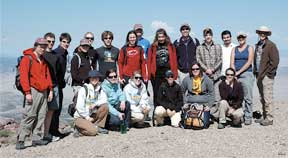2009 IRIS REU Internship Program Kicks Off with Orientation Week
This summer, 14 undergraduates from across the US will have the opportunity to work with leaders in seismological research, to travel to exotic sites for fieldwork, and to produce research products worthy of presentation at large professional conferences.
The interns recently completed a five-day orientation program in Socorro, New Mexico, hosted by the Earth and Environmental Science Department at New Mexico Tech and the IRIS PASSCAL Instrument Center. During the orientation, the interns participated in a range of classroom, lab and field experiences to prepare them for their summer research experience. These activities foster a strong sense of community among the interns while also providing an introduction to some of the most exciting aspects of modern seismology. In addition to IRIS staff, this year's faculty included Alan Kafka of Boston College; Randy Keller of the University of Oklahoma; and Cathy Snelson, Rick Aster, and other guest instructors from New Mexico Tech.
The 2009 class of 14 interns is the largest to date. The recent renewal of the Research Experiences for Undergraduates (REU) award, co-funded by the National Science Foundation and the Department of Defense, provides support for 12 interns, an increase from the ten interns that participated in the program in each of the previous three years. One of this year's interns is co-funded by USArray (a component of EarthScope) and another receives funding through a partnership with UNAVCO's Research Experience in Solid Earth Science for Students (RESESS) program (http://resess.unavco.org/).
Please visit the IRIS Internship website for further information on the orientation week or the IRIS REU Program (http://dev.iris.edu/internship/) or contact Michael Hubenthal at michael.hubenthal@earthscope.org.
|
2009 interns and program staff pose for a photo atop South Baldy Ridge in the Magdalena Mountains during the IRIS Internship Program orientation week. Photo courtesy of Kyle Crockett, Magdalena Ridge Observatory. |



